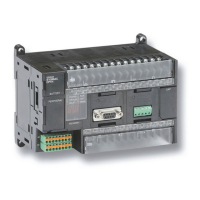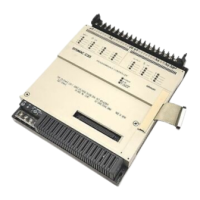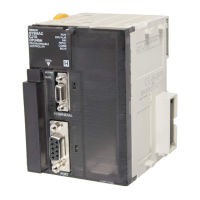Glossary
136
operand The values designated as the data to be used for an instruction. An operand can
be input as a constant expressing the actual numeric value to be used or as an
address to express the location in memory of the data to be used.
operating error An error that occurs during actual PC operation as opposed to an initialization
error and that occurs before actual operations can begin.
optical communications A communications method in which signals are sent over optical fiber cable to
prevent noise interference and increase transmission distance.
OR A logic operation whereby the result is true if either of two premises is true, or if
both are true. In ladder-diagram programming the premises are usually ON/OFF
states of bits or the logical combination of such states called execution condi-
tions.
output The signal sent from the PC to an external device. The term output is often used
abstractly or collectively to refer to outgoing signals.
Output Block A Unit used in combination with a Remote Interface to create an I/O Terminal. An
Output Block provides mounting positions for replaceable relays. Each relay can
be selected according to specific output requirements.
output device An external device that receives signals from the PC System.
output point The point at which an output leaves the PC System. Output points correspond
physically to terminals or connector pins.
output signal A signal being sent to an external device. Generally an output signal is said to
exist when, for example, a connection point goes from low to high voltage or from
a nonconductive to a conductive state.
Output Terminal An I/O Terminal that provides output points.
overflow The state where the capacity of a data storage location has been exceeded.
overwrite Changing the content of a memory location so that the previous content is lost.
parity Adjustment of the number of ON bits in a word or other unit of data so that the
total is always an even number or always an odd number. Parity is generally
used to check the accuracy of data after being transmitted by confirming that the
number of ON bits is still even or still odd.
parity check Checking parity to ensure that transmitted data has not been corrupted.
PC An acronym for Programmable Controller.
PC configuration The arrangement and interconnections of the Units that are put together to form
a functional PC.
PC System With building-block PCs, all of the Racks and independent Units connected di-
rectly to them up to, but not including the I/O devices. The boundaries of a PC
System are the PC and the program in its CPU at the upper end; and the I/O
Units, Special I/O Units, Optical I/O Units, Remote Terminals, etc., at the lower
end.
PCB An acronym for printed circuit board.
PC Setup A group of operating parameters set in the PC from a Programming Device to
control PC operation.
